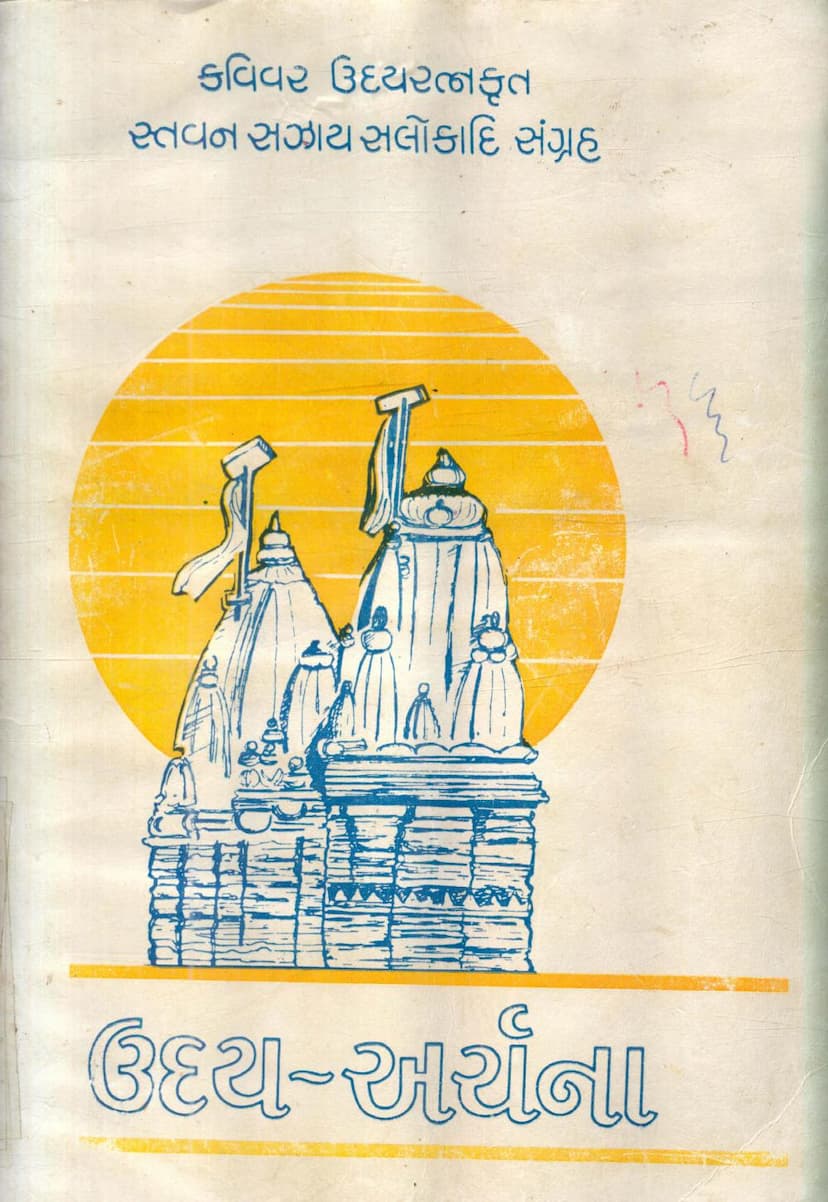Uday Archana
Added to library: September 2, 2025

Summary
Here is a comprehensive summary of the Jain text "Uday Archana," based on the provided pages:
Book Title: Uday Archana (ઉદય-અર્ચના) Author(s): Kantibhai B Shah, Vonochandra R Shah, Kirtida R Joshi (Editors) Publisher: Shri Udayratniji Shankheshwar Tirthyatra Smruti Sangh Author of Poems: Udayaratna Upadhyaya (Udayaratna Muni)
Overview:
"Uday Archana" is a collection of religious short poems (સ્તવન, સઝાય, સ્તુતિ, છંદ, સલોકા, etc.) by the esteemed Jain Sadhu-kavi (monk-poet) Upadhyaya Udayaratna (also known as Udayaratna Muni or Udayavachak). Udayaratna Upadhyaya lived approximately three hundred years ago, during the 17th-18th centuries. The book is an effort by the "Shri Udayaratna Shankheshwar Tirthyatra Smruti Sangh" to honor and present the works of this significant poet.
Key Information and Content:
-
The Poet Udayaratna Upadhyaya:
- He was a prominent Jain monk-poet whose works are widely known and sung in the Jain community.
- His active period of writing spans roughly from 1749 (VS 1693) to 1799 (VS 1743), indicating a significant contribution over half a century.
- He resided in or was closely associated with Kheda and its surrounding areas, as evidenced by his works mentioning these locations.
- His influence is noted in the construction of the Bhidbhanjan Parshvanath Jain temple in Kheda.
- A notable incident mentioned is his prayer leading to the miraculous opening of the doors of the Shankheshwar Parshvanath idol, which was held by a greedy Thakor.
- The editors have included biographical information, drawing from oral traditions and authentic historical records, to shed light on his life and works.
- Some accounts suggest his birthplace was Kheda, and he passed away in Miyagam. His parents are identified as Manakbai and Vardhaman of the Parwad community.
-
The "Shri Udayaratna Shankheshwar Tirthyatra Smruti Sangh":
- This Sangh was formed by individuals from Kheda with the purpose of commemorating a group pilgrimage to Shankheshwarji.
- The formation of the Sangh and the pilgrimage were inspired by the miraculous event associated with Udayaratna Upadhyaya at Shankheshwar.
- The publication of "Uday Archana" was conceived as a tribute to Upadhyaya Udayaratna in conjunction with this pilgrimage.
- The Sangh was supported by generous contributions from various individuals and families, as listed in the "Prakashakiya Nivedan" (Publisher's Note).
-
"Uday Archana" - The Book:
- The book's title, "Uday Archana" (Uday's Worship), signifies the worshipful offering of Udayaratna's poetry and a tribute to him as a significant poet who enriched medieval Gujarati literature.
- It is a compilation of his shorter poetic works, including Stavan (devotional songs), Sajhaya (narrative poems or moral tales), Stutis (praises), Chhand (metrical verses), and Saloka (verses, often didactic).
- The editors (Kantibhai B. Shah, Vinodchandra R. Shah, Kirtida R. Joshi) undertook the challenging task of collecting, categorizing, and meticulously editing these works, with guidance from Prof. Jayant Kothari.
- The collected works have been categorized into sections like Vandana (salutations), Stavane (devotional songs praising various Tirthankaras and holy places), Stutio (praises), Sajhaya (moral and narrative poems), Chhand (verses), Saloka (verses), and Rutuvarna (seasonal descriptions).
- The arrangement within these sections follows a logical order, often alphabetical or chronological by Tirthankara, where applicable.
- Some Vandana and Kshamaapana (apology) verses are extracted from his longer works like Rasa.
- The language, while generally modernized for readability, retains the essence of the original medieval Gujarati, with efforts to preserve the poetic rhythm and rhyme. Some poems are noted to have Hindi or Marwari influences.
- The book includes an introductory biographical essay on Udayaratna Upadhyaya, incorporating both popular legends and verifiable information.
- A comprehensive bibliography of Udayaratna's known works is provided at the end of the book.
-
Content of the Collection:
- The book contains a vast array of poems categorized by type and subject.
- Vandana: Includes salutations to Jinavaras, Gurus, Goddess Saraswati, Dharma, auspicious elements, and specific Tirthankaras and Tirthas.
- Stavane: Covers a wide range of devotional songs dedicated to all 24 Tirthankaras (starting with Rushabhdev, followed by Ajitnath, Sambhavnath, Abhinandanath, Sumatinath, Padmaprabh, Suparshvanath, Chandraprabh, Suvidhinath, Sheetalnath, Shreyanshanath, Vasupujya, Vimalnath, Anantnath, Dharmanath, Shantranath, Kunthunath, Aranath, Mallinath, Munisuvrataswami, Neminath, Parshvanath, and Mahavir Swami). It also includes praises for specific manifestations of Parshvanath (Bhidbhanjan, Shankheshwar, Godi) and general Tirthankara praises, as well as hymns dedicated to the Tirths of Shatrunjay (Siddhachal) and Girnar, and specific prayers related to religious observances.
- Sajhaya: Features numerous narrative and didactic poems on various themes, including stories of saints and devotees (Anathi Muni, Kapil Rishi, Chandanbala, Shalibhadra, Sita, Sthulibhadra), moral teachings (on anger, pride, greed, compassion, renunciation, charity, chastity), and allegorical tales (Jeev-rup-vanjara).
- Chhand: Includes metrical compositions, often related to specific Tirthankaras like Parshvanath and Gautam Swami, and descriptions of notable figures.
- Saloka: Contains verses that often convey moral or spiritual lessons.
- Rutuvarna: Features descriptions related to seasons, such as Nemnath's Termasa (thirteen-month cycle) and Parshvanath's Chomasa (four-month rainy season).
-
Significance:
- "Uday Archana" is a significant contribution to the preservation and study of medieval Jain literature and Gujarati poetry.
- The works of Udayaratna Upadhyaya are recognized for their devotional depth, poetic merit, and popularity among the Jain community, making them valuable for both religious and literary study.
- The book serves as an important resource for understanding Jain devotional practices and the historical literary landscape of Gujarat.
This summary highlights the key aspects of the text, covering the poet, the sponsoring organization, the book itself, its contents, and its overall significance in Jain literature.